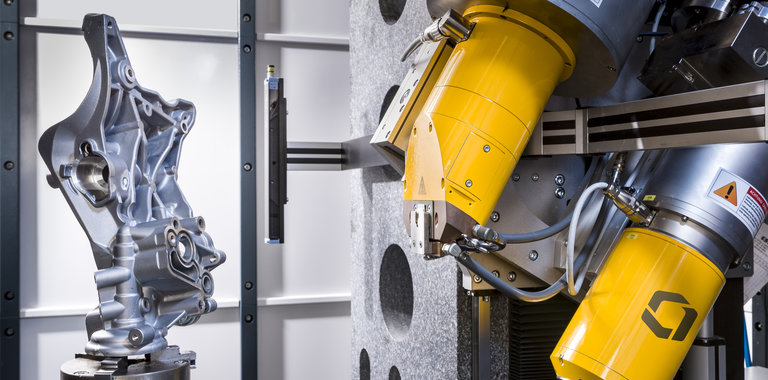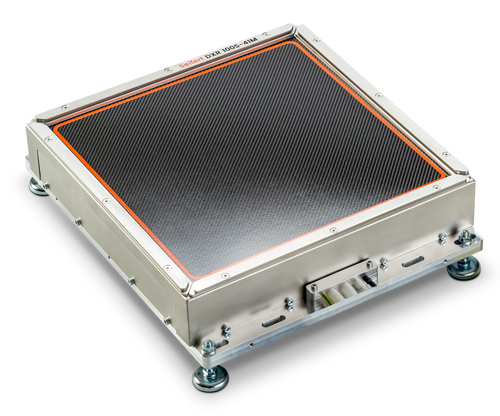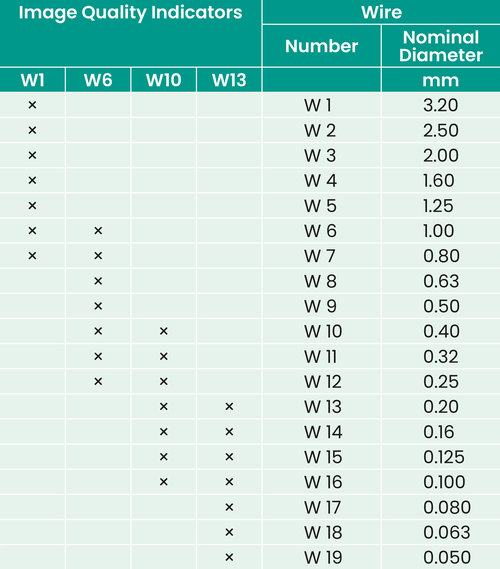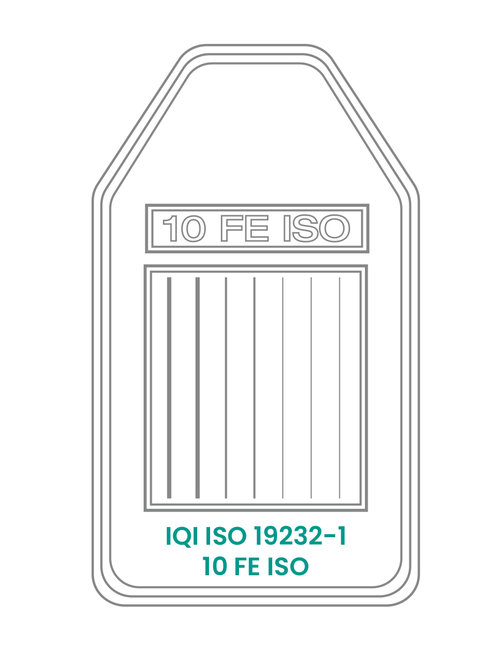
What are image quality indicators (IQIs)?
In this article:
- Image Quality Indicators (IQIs) Assess Radiographic Sensitivity: IQIs, also known as penetrameters, are reference tools used in radiographic testing to evaluate the image quality and ensure that inspection standards are met.
- IQIs Are Typically Made of Wires or Plates: Common types include wire-type indicators (used widely in Europe) and step-hole indicators (used in France), each designed to simulate flaw detectability across varying material thicknesses.
- IQIs Must Match the Material Being Tested: For accurate results, the IQI should be made of the same material as the test object and placed on the source side of the component; if placed on the film side, it must be marked with a lead “F”.
- Image Quality Is Expressed as a Percentage of Material Thickness: The smallest visible wire or hole on the radiograph is used to calculate a sensitivity percentage, helping quantify the system’s ability to detect small defects.
- IQIs Do Not Guarantee Flaw Detection: While they validate image quality, IQIs cannot confirm the absence of flaws—especially small or unfavorably oriented ones—highlighting the importance of proper technique and interpretation.
What are image quality indicators (IQIs)?
In the past it was thought possible to assess the smallest defect detectable, by fixing a simple type of indicator on the test object during exposure. This would supposedly guarantee that defects of a certain minimum size, expressed as a percentage of the material thickness, could be detected. In practice, however, this proved not to be achievable. In particular where small cracks and other two-dimensional defects are concerned, it can never be guaranteed that they are not in fact present when no indication of them can be found in the X-ray image.
However, it is reasonable to expect that at least the quality of the radiographs, and of course the rest of the entire process the film undergoes, meets certain requirements. The probability is high that defects will be more easily detected when the image quality is high. The exposure technique and required image quality, described in the code, depend on the purpose for which the object involved will be used.
In order to be able to assess and quantify the image quality of a radiograph, it needs to be converted into a numerical value, and to do this “image quality indicators” (IQI) are used, known in the USA as “penetrameters”. Image quality indicators typically consist of a series of wires of increasing diameters, or a series of small plates of different thicknesses, with holes drilled in them of increasing diameters.
Although codes describe their techniques differently, they agree on the following points:
- An image quality indicator shall be placed at the source-side of the object being examined,
- If it is not possible to place the indicator on the source-side, it may be located on the film-side. This exceptional situation must be indicated by a lead letter “F” on or directly adjacent to the indicator,
- ∑ The material of the indicator must be identical to the material being examined.
The image quality of a radiograph is, for example, defined as the number of the thinnest wire still visible, and is generally said to have “image quality number -X-”.
The image quality can also be expressed as a percentage of the object thickness examined.
If, for instance, the diameter of the thinnest wire visible to the naked eye is 0.2 mm and material thickness at the point of exposure is 10 mm, wire discernibility or wire recognizability is quoted as 2 %.
As emphasised above, the use of an IQI does not guarantee detection of defects of comparable size.
It would be incorrect to say that because a wire of 2 % of the object thickness can be seen on the radiograph, a crack of similar size can also be detected.
The orientation, relative to the X-ray beam, of a defect plays an important role in its discernibility.
There are various types of IQI, but the four most commonly used are:
- the wire type (used in most European countries)
- the step-hole type (still occasionally used in France, but the wire type is generally accepted as well).
- small plates with drilled holes, called penetrameters, which are used for ASME-work, although the ASME-code nowadays includes the wire-type IQI.
- the duplex IQI.
In some countries (e.g. Japan and France) additional means (such as step-wedges) are used, to verify contrast and check the kV-value used.
At the location of the (step)-wedge, there must be a minimum specified difference in density compared to the density at a location on the film where penetrated material thickness equals nominal wall thickness.
Wire-type IQI according to ISO 19232-1 (previously EN 462-1)
ISO 19232-1 standardizes four wire-type IQIs. Each one is made up of seven equidistant parallel wires of various diameters, as shown in the table.
The table shows the wire combinations for the four IQIs according to ISO 19232-1. The diameters of the wires are given below.
ISO-type IQIs are manufactured with wires of steel, aluminium, titanium or copper, depending on the type of material to be examined. On each IQI the wire material is indicated. Fe for steel, Al for aluminium, Ti for titanium and Cu for copper.
Wire IQIs according to ISO 19232-1



